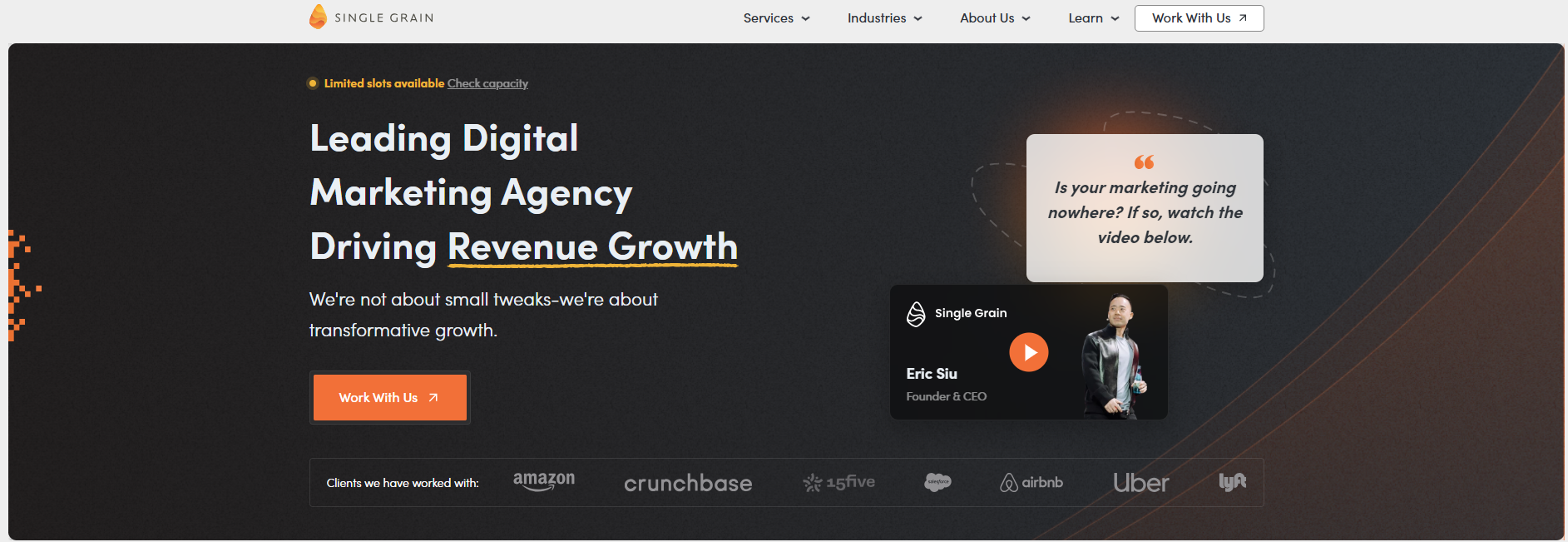How AIO Marketing Agencies Boost Performance
AI in the marketing industry is now worth $47.32 billion. Behind this explosive growth lies a fundamental transformation in how businesses approach marketing performance. At the center of this revolution are AIO (Artificial Intelligence Optimized) marketing agencies, redefining what’s possible for growth-stage companies.
For CMOs and marketing leaders who’ve watched traditional agencies struggle to deliver consistent, measurable results, AIO agencies represent something fundamentally different: a data-first approach that combines human strategic thinking with AI-powered execution to deliver performance gains that were simply impossible just a few years ago.
TABLE OF CONTENTS:
- Key Takeaways
- AIO Agencies Redefine Marketing Performance Through Intelligent Automation
- The Revenue Impact Framework: How AIO Drives Measurable Business Transformation
- Performance Gains By the Numbers: Real Business Impact
- Case Study: Content Marketing Delivers a 268% Increase in Clicks
- Full-Funnel Content Strategy Drives 229% More Website Conversions
- Enterprise-Scale AI SEO: Lead Generation Opportunity
- Strategic Implementation Considerations for Marketing Leaders
- Choosing the Right AIO Partner: Due Diligence Framework
- Maximizing Your AIO Partnership ROI
- Building Future-Ready Marketing Operations
- Related Video
Key Takeaways
- AIO agencies deliver measurable performance improvements through autonomous optimization that makes thousands of micro-adjustments daily, typically achieving 25-45% ROAS increases and 20-35% CPA reductions within 60-90 days
- Revenue-focused measurement frameworks replace vanity metrics as AIO agencies architect entire marketing systems around business outcomes like customer lifetime value, rather than impressions or click-through rates
- Data infrastructure quality directly impacts AI optimization results, with companies prioritizing data quality seeing 60% reduced operational costs
- Cross-channel learning acceleration multiplies performance gains as successful strategies automatically replicate across all marketing channels, creating compound improvements that traditional methods cannot match
- Strategic partnership approach maximizes long-term competitive advantage by treating AIO agencies as transformational investments that build future-ready marketing operations rather than traditional service relationships
AIO Agencies Redefine Marketing Performance Through Intelligent Automation
Traditional marketing agencies often rely on intuition, experience, and manual optimization processes, which can take weeks or months to yield results. AIO marketing agencies flip this model entirely, leveraging artificial intelligence to make thousands of micro-optimizations daily while human strategists focus on high-level growth planning and creative direction.
The transformation begins with data architecture. Where conventional agencies might analyze campaign performance weekly or monthly, AIO agencies process performance signals in real-time, adjusting targeting, creative elements, and budget allocation continuously. This creates what industry leaders call “autonomous optimization”—marketing systems that learn and improve without constant human intervention.
Consider the rapid adoption curve: 69% of marketers had already integrated AI into their strategies in 2024. This isn’t a slow-building trend; it’s a competitive arms race where early adopters are pulling ahead with measurable performance advantages.
The Revenue Impact Framework: How AIO Drives Measurable Business Transformation

AIO agencies operate on a fundamentally different performance model than traditional marketing partners. Instead of focusing on vanity metrics like impressions or click-through rates, they architect entire marketing systems around revenue attribution and business impact. This approach typically follows a four-stage transformation framework that compounds results over time.
The first stage involves data unification and intelligence gathering. AIO agencies connect disparate data sources, CRM systems, advertising platforms, email marketing tools, and website analytics into unified intelligence platforms that reveal customer journey patterns invisible to traditional analysis methods. This foundation enables the sophisticated targeting and personalization that drives performance gains.
Stage two focuses on predictive audience development. Using machine learning algorithms, AIO agencies identify high-value prospect segments before they enter your sales funnel. This predictive capability allows for proactive marketing investments rather than reactive campaign adjustments, fundamentally changing the economics of customer acquisition.
The third stage implements autonomous optimization across channels. While traditional agencies might optimize ad campaigns weekly, AIO systems make thousands of optimization decisions daily. Adjusting bids, rotating creative elements, and reallocating budget based on real-time performance signals. This creates performance improvements that traditional methods cannot match.
Finally, continuous learning and scaling ensure that successful strategies are automatically replicated and improved across all marketing channels. What works in paid search is tested in social media, and successful email personalization strategies inform display advertising approaches. This cross-channel learning acceleration is where AIO agencies deliver their most dramatic business impact.
Performance Gains By the Numbers: Real Business Impact
The performance improvements from AIO agency partnerships are transformational. Industry data reveals consistent patterns of significant business impact across multiple sectors and company sizes.
| Performance Metric | Typical Improvement Range | Time to Realization |
|---|---|---|
| Return on Ad Spend (ROAS) | 25-45% increase | 60-90 days |
| Cost Per Acquisition (CPA) | 20-35% reduction | 30-60 days |
| Email Revenue Attribution | 40-65% increase | 90-120 days |
| Conversion Rate Optimization | 30-50% improvement | 45-75 days |
| Customer Lifetime Value | 35-60% increase | 120-180 days |
42.2% of marketers say AI transformed their strategies, but the real transformation happens when AI optimization touches every aspect of the marketing funnel simultaneously.
Case Study: Content Marketing Delivers a 268% Increase in Clicks

Wine Deals faced several challenges when launching and scaling their brand. They had limited funding, faced heavy competition, high CACs, and difficulty building consumer trust. They partnered with Single Grain Marketing, which recommended an overhaul of their content marketing and SEO strategies. Single Grain optimized its blog with AI, achieving remarkable growth. This includes a 268% increase in clicks, and their average search ranking position reached 11.7% — up four spots from where they were before.
Full-Funnel Content Strategy Drives 229% More Website Conversions
Full-funnel content is one of the most significant opportunities for AIO agencies. Traditional content marketing approaches miss a massive opportunity because they ignore customer intent and fail to encourage users to convert.
LS Building Products, a building materials supplier, struggled to generate website traffic. They had limited content on their website, and what they had wasn’t converting website visitors. LS Building Products partnered with Single Grain Marketing, which transformed its content strategy. Full-funnel content attracts and educates more website visitors, which boosts conversions.
The impact was substantial: organic traffic was lifted by 206% and conversions increased by 229%.
Enterprise-Scale AI SEO: Lead Generation Opportunity
AIO agencies can implement an effective SEO strategy at enterprise scale by using AI. Agencies not only optimize your website for Google but also for multiple AI search engines, such as ChatGPT and Perplexity.
Smart Rent exemplifies this approach with this case study. Instead of optimizing their organic strategy for only Google, they improved their AI search visibility. The results demonstrate the power of AI in SEO: a 32.1% increase in lead generation and a 200% increase in AI search visibility.
Strategic Implementation Considerations for Marketing Leaders
Successfully partnering with an AIO agency requires more than selecting the right technology. It demands a strategic approach to data preparation, team alignment, and performance measurement that sets the foundation for transformational results.
Data readiness represents the most critical success factor. AIO agencies require clean, connected data sources to deliver their most powerful optimizations. Companies with fragmented data systems or inconsistent tracking implementations will need to invest in data infrastructure before realizing the full benefits of AI-powered marketing optimization.
Team integration also requires careful planning. The most successful AIO implementations occur when internal marketing teams grasp their evolving role within an AI-optimized environment. Rather than replacing human creativity and strategic thinking, AI marketing agencies amplify human capabilities by automating data-heavy optimization tasks.
Performance measurement standards must also evolve. Traditional marketing metrics, such as impressions and click-through rates, become less relevant when AIO systems optimize for business outcomes like revenue and customer lifetime value. Marketing leaders need to establish new measurement frameworks that align with business impact rather than channel-specific vanity metrics.
Choosing the Right AIO Partner: Due Diligence Framework
Not all agencies claiming AI expertise deliver transformational results. Marketing leaders require a systematic approach to evaluating AIO partners, one that goes beyond impressive technology demonstrations to focus on proven business impact and strategic alignment.
- Revenue Attribution Capabilities: Strong AIO agencies demonstrate clear connections between AI optimizations and business outcomes, not just campaign metrics.
- Data Integration Expertise: Look for agencies with proven experience connecting complex marketing technology stacks into unified intelligence platforms.
- Industry-Specific Experience: The best AIO agencies understand the unique challenges and opportunities in your specific market vertical.
- Transparent Optimization Processes: Avoid “black box” approaches. The best AIO partners explain their optimization strategies and provide ongoing education for internal teams.
- Scalable Growth Frameworks: Ensure the agency can grow with your business rather than requiring complete rebuilds as you scale.
The due diligence process should also include detailed case studies from similar companies in your industry. Generic success stories matter less than specific examples of how the agency has driven measurable business transformation for companies facing similar challenges to yours.
Maximizing Your AIO Partnership ROI
The most successful AIO agency partnerships create value that extends far beyond initial performance improvements. Smart marketing leaders approach these partnerships as transformational investments rather than traditional service relationships, positioning their organizations for sustained competitive advantages.
Start with clear business outcome objectives rather than channel-specific goals. Instead of “improve Facebook ad performance,” define success as “reduce customer acquisition cost by 25% while increasing customer lifetime value by 40%.” This outcome-focused approach enables AIO agencies to optimize across all marketing channels toward your most important business metrics.

Invest in data infrastructure early in the partnership. The quality of your data directly impacts the sophistication of AI optimizations your agency can deliver. Companies that prioritize data quality reduce operational costs by 60%.
Create internal learning systems that capture and distribute insights from your AIO partnership. The most valuable long-term benefit isn’t just improved performance, it’s the strategic intelligence about your customers and markets that AI analysis reveals. Organizations that systematically capture and apply these insights create sustainable competitive advantages that extend far beyond marketing performance.
For marketing leaders looking to transform their business performance through AI-powered optimization, the window for competitive advantage remains open but is narrowing rapidly. Work with the leading AI optimization agency to discover how AIO strategies can drive measurable business transformation for your organization.
Building Future-Ready Marketing Operations
The transformation from traditional marketing to AIO-powered growth represents more than a technology upgrade. It’s a fundamental shift in how successful companies approach customer acquisition, retention, and revenue growth. As AI capabilities continue advancing throughout 2025 and beyond, the performance gap between AI-optimized and traditional marketing approaches will only widen.
Marketing leaders who invest now in AIO partnerships position their organizations not just for immediate performance gains, but for sustained competitive advantages in an increasingly AI-driven marketplace. The companies poised to dominate their markets in the coming years aren’t just leveraging AI tools; they’re building entire marketing operations around AI-powered intelligence and optimization.
The question for growth-minded marketing leaders isn’t whether to embrace AIO marketing strategies, but how quickly they can implement them. Every day of delay represents missed opportunities for performance improvements that compound over time, making early action not just strategic but essential for maintaining competitive positioning in rapidly evolving markets.
Related Video
For more insights and lessons about marketing, check out our Marketing School podcast on YouTube.
Frequently Asked Questions
-
What makes AIO agencies different from traditional marketing agencies?
AIO agencies use artificial intelligence to make thousands of micro-optimizations daily, while traditional agencies rely on manual processes and periodic campaign reviews. They focus on autonomous optimization that continuously adjusts targeting, creative elements, and budget allocation in real-time, freeing human strategists to focus on high-level growth planning and creative direction.
-
What kind of performance improvements can I expect from an AIO agency partnership?
Clients have experienced a 268% increase in clicks, 229% more conversions, and a 32.1% boost in lead generation.
-
How important is data quality for AIO agency success?
Data infrastructure quality directly impacts AI optimization results. AIO agencies require unified data from CRM systems, advertising platforms, email tools, and website analytics to deliver their most powerful optimizations.
-
What should I look for when evaluating potential AIO agency partners?
Focus on revenue attribution capabilities, data integration expertise, industry-specific experience, transparent optimization processes, and scalable growth frameworks. Avoid ‘black box’ approaches and prioritize agencies that can demonstrate clear connections between AI optimizations and business outcomes, not just campaign metrics.
-
How do AIO agencies measure success differently than traditional agencies?
AIO agencies architect entire marketing systems around revenue attribution and business outcomes like customer lifetime value, rather than vanity metrics like impressions or click-through rates. They establish measurement frameworks that align with business impact and optimize across all channels toward the most important business metrics.
-
What preparation is needed before partnering with an AIO agency?
Ensure your data infrastructure is ready by connecting disparate data sources into unified intelligence platforms and establishing consistent tracking implementations. Define clear business outcome objectives rather than channel-specific goals, and prepare your internal team to understand their evolving role in an AI-optimized environment.
-
How does cross-channel optimization work in AIO marketing?
AIO systems analyze performance patterns across all marketing channels simultaneously, automatically replicating successful strategies from one channel to another. What works in paid search gets tested in social media, and successful email personalization strategies inform display advertising approaches, creating compound improvements that traditional methods cannot match.




